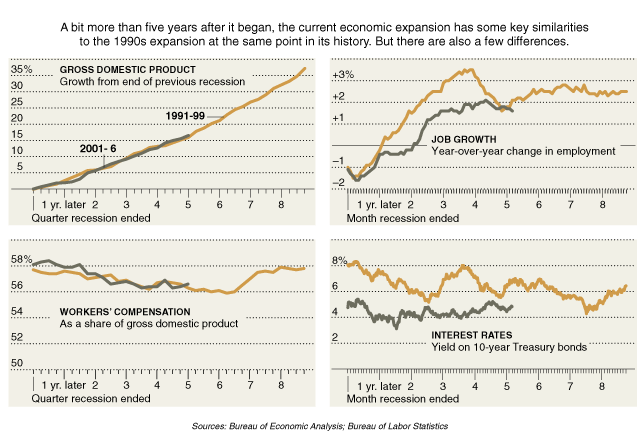Economics 302: Intermediate Macroeconomic Theory
This site provides resources for students in Economics 302
at the University of Wisconsin,
Madison for Spring 2007 Semester

Chart from E. Porter and J.W. Peters, "This expansion looks familiar," NYT, February 13, 2007.
Syllabus |
Important Dates |
Downloadable Course Materials and Information Sources |
Department of Economics
Robert M. LaFollette School of Public Affairs |
LECTURE: MW 2:30-3:45, 5106 Social Sciences
Section 301: R 8:50, 58 Bascom
Section 302: R 9:55, 14 Ingraham
Section 303: F 11:00, 6228 Social Sciences
Section 304: F 3:30, 5322 Social Sciences
Section 305: F 9:55, 6102 Social Sciences
Instructor
Professor Menzie Chinn
Office Hours: MW 1:15-2:15
Office: 7418 Social Sciences Bldg.
Phone: (608) 262-7397
email:
mchinn at lafollette.wisc.edu
Home Page
Teaching Assistant
Seung Gyu Sim
Office Hours: Th,F 2:20-3:20 (tentative)
Office: 7226 Social Sciences Bldg.
Phone: (608) 262-5353
Webpage:
email:
seunggyusim at wisc.edu
Home Page
Econ 302 Syllabus in PDF file.
Economics 302 is a course in intermediate macroeconomic theory and policy analysis. Students should have a familiarity with algebra (solving simultaneous equations).
Knowledge of basic calculus (partial and total differentials) and introductory statistics (linear regression) will be helpful, but not required.
The main part of the course will focus on the IS-LM framework. However, considerable attention will be devoted to international aspects, such as the trade deficit,
international capital flows and the exchange rate, as well as domestic issues such as inflationary processes.
Students enrolling in this course should be comfortable with algebraic and graphical analysis.
It requires sustained immersion in relevant economic theory, and does not present a primarily descriptive or historical approach.
One semester of calculus (Math 221 or 211) is required. Math 221 is recommended.
- Midterm 1, Monday, 2/19 in Social Sciences 5208
- Midterm 2, Monday, 3/26 in Social Sciences 5208
- Final Exam, Tuesday, 5/15 12:25PM Bascom 165

Downloadable Course Materials
Required On-line Readings
- Trehan, "Why has output become less volatile?" FRBSF Economic Letters 2005-24 September 16, 2005.
- Fernald and Wang, "Shifting Data: A Challenge for Monetary Policymakers," FRBSF Economic Letters 2005-35 December 9, 2005.
- Wu,"Two Measures of Employment: How Different Are They?" FRBSF Economic Letters 2004-23 August 27, 2004.
- Summary and Chapter 2 from CBO, Economic and Budget Outlook, January 2007 (Entire document here).
- The IS-LM Model
- Chapters of White House Council of Economic Advisers, The Economic Report of the President, 2007, Overview and Chapter 1. (Entire document here.)
- Notes on Aggregate Demand - Aggregate Supply
- Notes on AD-AS with Supply Shocks
- Fernald and Trehan,"Why Hasn't the Jump in Oil Prices Led to a Recession?" FRBSF Economic Letters 2005-31 November 18, 2005.
- Doms,"IT Investment: Will the Glory Days Ever Return?" FRBSF Economic Letters 2005-13 June 17, 2005.
- Notes on Open Economy Macro
- Chinn,"Getting Serious about the Twin Deficits," CSR 10, Council on Foreign Relations, September 2005.
- Transactions and Portfolio Crowding Out

- Notes on Markup Pricing
- Meyer, "Practical problems and obstacles to inflation targeting," FRB St. Louis Review 86(4) July 2004: 151-160.
- Anderson and Kliesen,
"The 1990s acceleration in labor productivity: causes and measurement" St. Louis Fed Review, May 2006: 181-204.
Additional Optional Readings
- Paul Krugman, "Who Was Milton Friedman?" New York Review of Books 54(2), February 15, 2007.
- "This expansion looks familiar," New York Times, February 13, 2007.
- G. Ip, "Policy Makers At Fed Rethink Inflation's Roots," WSJ, February 26, 2007. [sub.req.] (PDF version here)
- Bloomberg Special Report: Subprime Mortgage Crisis.

News Reports
News Sources
Weblogs and Perspectives
Economics and Economic Policy Links
International Organizations
U.S. Government Agencies
Current and Historical Data
- St. Louis Fed economic database Thousands
of time series on economic activity, in an easily downloadable form.
- Yahoo finance website Current financial data.
- ino.com Futures data.
- White House Economic Briefing Room Contains
current economic data.
- Federal Reserve Board data Monetary, financial and output data
collected by the Nation's central bank.
- Bureau of Economic Analysis, Dept. of Commerce Data on GDP and components (the national income and product accounts) as well as other macroeconomic data.
- Bureau of the Census, Dept. of Commerce Data on the characteristics
of the US population as well as of US firms.
- Bureau of Labor Statistics, Dept. of Labor Data on
wages, prices, productivity, and employment and unemployment rates.
- Energy Information Agency, Dept. of Energy Data on
on energy (electricity, gas, petroleum) production, consumption and prices.
- Statistical Abstract of the US
A compilation of statistics about the US, from government and nongovernment sources.
- Economic Report of the President, various years. The back portion of
this annual publication contains about 70 tables of government economic data.
- Economic Time Series page A large collection of economic time series.
- NBER Data Specialized economic databases created by
economists associated with the National Bureau of Economic Research.
Economics 302 Intermediate Macro / UW Madison / mchinn@lafollette.wisc.edu / 21 May 2007

